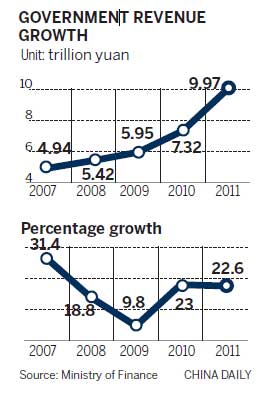Last year the Central Committee told the provincial governments that, beginning in 2012 they would be require to track and improve their provinces' GINI coefficients–the international standard for measuring and comparing income inequality. Of course, like most "new" legislation in China, this had been in the works for years and followed thousands of hours of consultations with foreign and domestic experts.
But how would the already-overwhelmed provinces make any significant impact on a problem that has plagued China (except during Mao's tenure) for thousands of years? Here's the answer, via China Daily:
State Council set to approve move to narrow gap
between rich and poor
A new income-distribution framework is set for approval to redress the growing gap betweenrich and poor, government officials said.
The framework comes at a time when the most affluent 10 percent of the population make 23times more than the poorest 10 percent.
In 1988 it was seven times.
The framework, eight years in the making, has been tabled for approval by the State Counciland is likely to be introduced in the second half of this year.
"If low-income families cannot afford a decent standard of living, rich families will not enjoy anysense of security. That is a problem for the world, not just China," Yang Yiyong, director of theSocial Development Research Institute under the National Development and ReformCommission, said in an interview with China Daily.
Yang has been closely involved in the framework'splanning. Its overarching guideline, he said, is "for thegovernment to give up a little tax revenue, for companies togive up a little profit and for rich people to give up a littleinterest."
Tax revenue grew from 7.3 trillion yuan ($1.12trillion) in 2010 to nearly 9 trillion yuan in 2011, a22.6 percent increase. It greatly outpaced urbanincome growth, 8.4 percent, and rural incomegrowth, 11.4 percent.
Per capita income in China has just exceeded$4,000.
As part of income-distribution reform, governmentagencies, at both central and local levels, will beurged to pass legislation to cut taxes and regulateexecutive pay in high-profit monopoly industriesand private companies, Yang said.
The framework will see an enlarged middle-incomegroup and high earners will pay more in tax.
It is time for common prosperity, Yang declared,although one government plan is not going toprovide all the answers to the thorny issue ofincome distribution in a society of 1.3 billion people.
This is not just about individual tastes or lifestyle, economists point out. It reflects a yawninggap between rich and poor that is hindering the world's second-largest economy from makingfurther progress and perhaps eroding its very social fabric, Yang said.
Gini coefficient
The framework may use the Gini coefficient, an internationally accepted gauge of incomeinequality, or adopt a mix of indicators, such as urban-rural income disparity or wagedifferences among various industries.
Targets would almost certainly be more powerful than persuasion, he said.
The country’s Gini coefficient has already reached a high, if not dangerous level. It is close to0.5, he said, a point that "is threatening" social security. Little room is left for the index to grow.
The last time the government reported the Gini coefficient was in 2000, when it stood at 0.412.
The National Bureau of Statistics said 2011’s Gini coefficient was "a little higher than 2010,"without specifying either number. In January, the NBS said the main reason that China did notrelease the figure because data about high-income groups was still incomplete.
 Adjusting interests
Adjusting interests
Chi Fulin, president of the China Institute for Reform and Development, called for theimmediate release of the framework.
"A crucial question is whether government agencies are willing to reorient their own interestsand surrender their privileges," he said.
Chi said the state capital and revenue should be a major source of social welfare and state-owned operations should contribute more to public welfare.
More revenue should be taken from state-owned companies, from the current 10 to 15 percentto about 25 percent in five years, he suggested.
"After 30 years of reform and opening up, the country is facing a second round of marketreform driven by fairness and sustainability, which is more challenging," Chi said.
"Consumption will be a major force to keep rapid economic growth in the coming 10 to 20years, and narrowing the income gap is a precondition to release the great consumptionpotential," Chi said.
Equal opportunities
Solutions provided by policymakers must "get to the root of the problem", said Chen Shaohua,a Washington-based senior statistician at the World Bank’s Economic Research Group.
The country needs to provide an ascending corridor for the less well-off to prevent povertypassing from generation to generation, Chen said.
She cited a cash transfer program in Brazil as an example. The government pays about $120per month, on average, to low-income families if they send their children to school. This hasboosted school attendance.
Income inequality has gradually decreased in many Latin American countries due tocontinuous investment in education.
"The root solution lies in improving the equality of opportunity," Chen said
http://www.chinadaily.com.cn/china/2012-05/23/content_15360815.htm



No comments:
Post a Comment
Please leave constructive comments about this post